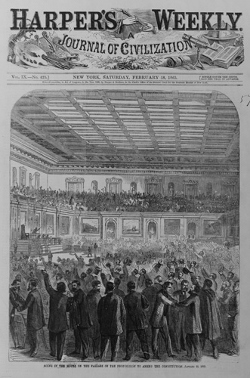A sad and sorry continuity: the North in Spielberg’s “Lincoln”
Saturday, November 17th, 2012 This entry by Producer/Director Katrina Browne is cross-posted from the blog of the Tracing Center, the nonprofit founded to carry on the mission inspired by Traces of the Trade.
This entry by Producer/Director Katrina Browne is cross-posted from the blog of the Tracing Center, the nonprofit founded to carry on the mission inspired by Traces of the Trade.
I’m one of the jaded ones now.
So it surprised me not to find Fernando Wood rearing his pro-slavery head again, this time as a Democratic Congressman from New York. Here he was on the big screen in Steven Spielberg’s film Lincoln, showing up in 1865 as a vocal opponent in Congress to the passage of the 13th amendment. I knew of him from four years earlier, when in 1861, as mayor of New York City, on the heels of South Carolina’s secession, he proposed that the city should also secede from the Union. He was well aware that New York’s economy was inextricably tied to slavery.
Once you know about the North’s complicity in slavery and racism you see the through-line almost everywhere you look. The winter-spring of 1865 that is the subject of Lincoln thus becomes just one more chapter.
In the popular, white, non-southern imagination, we put Lincoln on a pedestal, but we subconsciously put ourselves on that pedestal too, because he is our symbol of northern determination to end slavery. That was us. The good guys.


